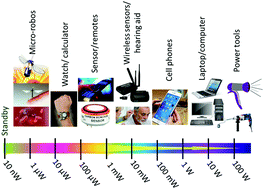当前位置:
X-MOL 学术
›
Sustain. Energy Fuels
›
论文详情
Our official English website, www.x-mol.net, welcomes your
feedback! (Note: you will need to create a separate account there.)
Magnetic energy harvesting with magnetoelectrics: an emerging technology for self-powered autonomous systems
Sustainable Energy & Fuels ( IF 5.0 ) Pub Date : 2017-10-03 00:00:00 , DOI: 10.1039/c7se00403f Venkateswarlu Annapureddy 1, 2, 3, 4 , Haribabu Palneedi 1, 2, 3, 4 , Geon-Tae Hwang 1, 2, 3, 4 , Mahesh Peddigari 1, 2, 3, 4 , Dae-Yong Jeong 4, 5, 6, 7 , Woon-Ha Yoon 1, 2, 3, 4 , Kwang-Ho Kim 4, 8, 9, 10 , Jungho Ryu 1, 2, 3, 4
Sustainable Energy & Fuels ( IF 5.0 ) Pub Date : 2017-10-03 00:00:00 , DOI: 10.1039/c7se00403f Venkateswarlu Annapureddy 1, 2, 3, 4 , Haribabu Palneedi 1, 2, 3, 4 , Geon-Tae Hwang 1, 2, 3, 4 , Mahesh Peddigari 1, 2, 3, 4 , Dae-Yong Jeong 4, 5, 6, 7 , Woon-Ha Yoon 1, 2, 3, 4 , Kwang-Ho Kim 4, 8, 9, 10 , Jungho Ryu 1, 2, 3, 4
Affiliation

|
The deployment of wireless sensor networks (WSNs) for the internet of things (IoT) and remote monitoring devices has made tremendous progress in the last few years. At the same time, energy harvesters are also being developed to satisfy the power requirement of WSNs and other low power consumption electronics, to increase the device operating time and overcome the limitations of conventional electric power supplies, including batteries. Among various resources for energy harvesting, the magnetic noise produced by power transmission infrastructures and associated mechanical vibrations are ubiquitous energy sources that could be converted into electricity by high efficiency energy conversion materials or devices. Electromagnetic energy conversion systems that operate on the principle of Faraday's induction law can provide sufficient power from strong magnetic fields. However, under weak magnetic fields with low frequency such as 50/60 Hz, the power generated from an electromagnetic device is disappointingly small. Alternative energy harvesting technologies with high power density and small device volume/dimensions are obviously necessary for WSNs of IoT. In this review article, the current status and prospects of an emerging magnetic energy harvesting technology, the so-called magneto-mechano-electric (MME) generators, are reviewed. MME generators utilize the magnetoelectric (ME) coupling in composites of piezoelectric and magnetostrictive materials and interaction between the proof magnet mass and magnetic field. Since the piezoelectric phase in the composite also responds to mechanical vibration directly, an ME-based energy harvester can harness energy from both mechanical vibrations and magnetic fields simultaneously. This combination is expected to enhance the total power output and conversion efficiency. The MME generator can be a ubiquitous power source for WSNs, low power electronic devices, and wireless charging systems by harvesting energy from the tiny magnetic fields present as parasitic magnetic noise in an ambient environment.
中文翻译:

利用磁电技术收集磁能:一种用于自供电自主系统的新兴技术
在过去的几年中,用于物联网(IoT)和远程监控设备的无线传感器网络(WSN)的部署取得了巨大的进步。同时,还开发了能量收集器,以满足WSN和其他低功耗电子设备的功率要求,以增加设备的工作时间并克服包括电池在内的常规电源的局限性。在各种能量收集资源中,动力传输基础设施产生的磁噪声和相关的机械振动是无处不在的能源,可以通过高效的能量转换材料或设备将其转换为电能。按照法拉第原理工作的电磁能量转换系统 感应定律可以从强磁场中提供足够的功率。然而,在诸如50 / 60Hz的低频弱磁场下,从电磁装置产生的功率令人失望地小。对于物联网的无线传感器网络而言,具有高功率密度和小设备体积/尺寸的替代性能量收集技术显然是必需的。在这篇综述文章中,回顾了一种新兴的磁能收集技术(即所谓的磁-机电(MME)发电机)的现状和前景。MME发电机利用压电和磁致伸缩材料的复合材料中的磁电(ME)耦合,以及证明磁石质量和磁场之间的相互作用。由于复合材料中的压电相也直接响应机械振动,基于ME的能量采集器可以同时利用来自机械振动和磁场的能量。这种组合有望提高总功率输出和转换效率。通过从周围环境中作为寄生磁噪声存在的微小磁场中收集能量,MME发生器可以成为WSN,低功率电子设备和无线充电系统的普遍电源。
更新日期:2017-10-26
中文翻译:

利用磁电技术收集磁能:一种用于自供电自主系统的新兴技术
在过去的几年中,用于物联网(IoT)和远程监控设备的无线传感器网络(WSN)的部署取得了巨大的进步。同时,还开发了能量收集器,以满足WSN和其他低功耗电子设备的功率要求,以增加设备的工作时间并克服包括电池在内的常规电源的局限性。在各种能量收集资源中,动力传输基础设施产生的磁噪声和相关的机械振动是无处不在的能源,可以通过高效的能量转换材料或设备将其转换为电能。按照法拉第原理工作的电磁能量转换系统 感应定律可以从强磁场中提供足够的功率。然而,在诸如50 / 60Hz的低频弱磁场下,从电磁装置产生的功率令人失望地小。对于物联网的无线传感器网络而言,具有高功率密度和小设备体积/尺寸的替代性能量收集技术显然是必需的。在这篇综述文章中,回顾了一种新兴的磁能收集技术(即所谓的磁-机电(MME)发电机)的现状和前景。MME发电机利用压电和磁致伸缩材料的复合材料中的磁电(ME)耦合,以及证明磁石质量和磁场之间的相互作用。由于复合材料中的压电相也直接响应机械振动,基于ME的能量采集器可以同时利用来自机械振动和磁场的能量。这种组合有望提高总功率输出和转换效率。通过从周围环境中作为寄生磁噪声存在的微小磁场中收集能量,MME发生器可以成为WSN,低功率电子设备和无线充电系统的普遍电源。











































 京公网安备 11010802027423号
京公网安备 11010802027423号